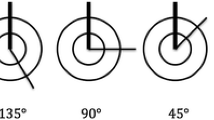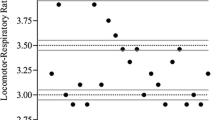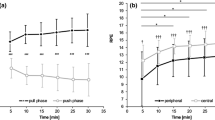Abstract
The aim of this study was to evaluate the effects of using asymmetric crank arms in cyclists affected by an inequality in lower limb length. Three male cyclists with a lower limb length difference of 28, 14, and 10 mm performed three experimental test sessions separated by 5 days, which were conducted using three different crank arm length conditions (170 mm for the long lower limb and 170, 165, and 160 mm for the short lower limb). Each test session included one 8-min pedalling exercise at 60% of maximal power output, two 10-s sprints, and one 30-s Wingate test. Power output was assessed during the supra-maximal exercises; while, physiological (heart rate, oxygen consumption, gross efficiency, and cycling economy) and biomechanical (hip, knee and ankle 2D kinematics) variables were measured during the submaximal exercises. Perceived exertion and perceived comfort were evaluated during all pedalling exercises. The results showed that the shortening of the crank length for the short lower limb (160 and 165 vs. 170 mm) reduced the knee and ankle extension and the hip and knee range of motion. In addition, the maximal power output and the perceived comfort were improved, while the perceived exertion was reduced. Therefore, the use of asymmetric crank arms during cycling could compensate for lower limb length discrepancy by modifying joint kinematics and by improving performance and perceived comfort.





Similar content being viewed by others
References
Silberman MR, Webner D, Collina S, Shiple BJ (2005) Road bicycle fit. Clin J Sport Med 15(4):271–276. https://doi.org/10.1097/01.jsm.0000171255.70156.da
Stefanyshyn DJ, Wannop JW (2015) Biomechanics research and sport equipment development. Sports Eng 18(4):191–202. https://doi.org/10.1007/s12283-015-0183-5
Gonzalez H, Hull ML (1989) Multivariable optimization of cycling biomechanics. J Biomech 22(11–12):1151–1161. https://doi.org/10.1016/0021-9290(89)90217-0
Ferrer-Roca V, Rivero-Palomo V, Ogueta-Alday A, Rodríguez-Marroyo JA, García-López J (2017) Acute effects of small changes in crank length on gross efficiency and pedalling technique during submaximal cycling. J Sports Sci 35(14):1328–1335. https://doi.org/10.1080/02640414.2016.1215490
De Vey MK (1998) Personal perspective: in search of an optimum cycling posture. Appl Ergon 29(5):325–334. https://doi.org/10.1016/S0003-6870(97)00080-X
Holmes JC, Pruitt AL, Whalen NJ (1994) Lower extremity overuse in bicycling. Clin Sports Med 13(1):187–205
McCaw ST, Bates BT (1991) Biomechanical implications of mild leg length inequality. Br J Sports Med 25(1):10–13. https://doi.org/10.1136/bjsm.25.1.10
Knutson GA (2005) Anatomic and functional leg-length inequality: a review and recommendation for clinical decision-making. Part I, anatomic leg-length inequality: prevalence, magnitude, effects and clinical significance. Chiropr Osteopat 13(11):1–10. https://doi.org/10.1186/1746-1340-13-11
Macdermid PW, Mann ME (2015) An integrated analysis of leg length differences and the effect of correctional techniques on stroke mechanics and performance indicators in competitive cyclists. Sports Exerc Med Open J 2(1):14–21. https://doi.org/10.17140/SEMOJ-1-1030
Bouillod A, Retali M, Soto-Romero G et al (2017) Acute effect of biomechanical foot orthotics on gross efficiency in cyclists affected by an anatomic asymmetry in time trial position. Comput Method Biomech 20(Sup1):23–24. https://doi.org/10.1080/10255842.2017.1382842
Millour G, Retail M, Brunet E, Nicolas G, Grappe F, Bouillod A, Bideau N (2016) Preliminary study: the effect of biomechanical foot orthotics in bilateral pedalling asymmetry in three cyclists affected by an anatomic asymmetry. J Sci Cycling 5(2):43–44
Wadsworth DJ, Weinrauch P (2019) The role of a bike fit in cyclists with hip pain. A clinical commentary. Int J Sports Phys 14(3):468. https://doi.org/10.26603/ijspt20190468
Martin JC, Spirduso WW (2001) Determinants of maximal cycling power: crank length, pedaling rate and pedal speed. Eur J Appl Physiol 84(5):413–418. https://doi.org/10.1007/s004210100400
Hull ML, Gonzalez H (1988) Bivariate optimization of pedalling rate and crank arm length in cycling. J Biomech 21(10):839–849. https://doi.org/10.1016/0021-9290(88)90016-4
Asplund C, St Pierre P (2004) Knee pain and bicycling: fitting concepts for clinicians. Phys Sportsmed 32(4):23–30. https://doi.org/10.3810/psm.2004.04.201
Mileva K, Turner D (2003) Neuromuscular and biomechanical coupling in human cycling. Exp Brain Res 152(3):393–403. https://doi.org/10.1007/s00221-003-1561-y
Macdermid PW, Edwards AM (2010) Influence of crank length on cycle ergometry performance of well-trained female cross-country mountain bike athletes. Eur J Appl Physiol 108(1):177–182. https://doi.org/10.1007/s00421-009-1197-0
McDaniel J, Durstine JL, Hand GA, Martin JC (2002) Determinants of metabolic cost during submaximal cycling. J Appl Physiol 93(3):823–828. https://doi.org/10.1152/japplphysiol.00982.2001
Priego Quesada JI, Kerr ZY, Bertucci WM, Carpes FP (2018) The categorization of amateur cyclists as research participants: findings from an observational study. J Sports Sci 36(17):2018–2024. https://doi.org/10.1080/02640414.2018.1432239
Harriss DJ, MacSween A, Atkinson G (2017) Standards for ethics in sport and exercise science research: 2018 update. Int J Sports Med 38(14):1126–1131. https://doi.org/10.1055/s-0043-124001
Hopker J, Coleman D, Passfield L (2009) Changes in cycling efficiency during a competitive season. Med Sci Sports Exerc 41(4):912–919. https://doi.org/10.1249/MSS.0b013e31818f2ab2
Mcgowan C, Watson G (2019) WahooKICKR18 and common bike-mounted power meters–Do they output accurate power data? J Sci Med Sport 22(S2):S95. https://doi.org/10.1016/j.jsams.2019.08.117
Vogler AJ, Rice AJ, Gore CJ (2010) Validity and reliability of the Cortex MetaMax3B portable metabolic system. J Sports Sci 28(7):733–742. https://doi.org/10.1080/02640410903582776
Faria EW, Parker DL, Faria IE (2005) The science of cycling: factors affecting performance–Part 2. Sports Med 35(4):313–338. https://doi.org/10.2165/00007256-200535040-00003
Price D, Donne B (1997) Effect of variation in seat tube angle at different seat heights on submaximal cycling performance in man. J Sports Sci 15(4):395–402. https://doi.org/10.1080/026404197367182
Della Croce U, Cappozzo A, Kerrigan DC (1999) Pelvis and lower limb anatomical landmark calibration precision and its propagation to bone geometry and joint angles. Med Biol Eng Comput 37(2):155–161. https://doi.org/10.1007/BF02513282
Millour G, Duc S, Puel F, Bertucci W (2019) Comparison of two static methods of saddle height adjustment for cyclists of different morphologies. Sports Biomech. https://doi.org/10.1080/14763141.2018.1556324
Borg GA (1982) Psychophysical bases of perceived exertion. Med Sci Sports Exerc 14(5):377–381
Cohen J (1988) Statistical power analysis for the behavioral sciences. Routledge Academic, Hillsdale, New Jersey
Hice GA, Kendrick Z, Weeber K, Bray J (1985) The effect of foot orthoses on oxygen consumption while cycling. J Am Podiatr Med Assoc 75(10):513–516. https://doi.org/10.7547/87507315-75-10-513
Priego Quesada JI, Pérez-Soriano P, Lucas-Cuevas AG, Salvador Palmer R, Ortiz C, de Anda RM (2017) Effect of bike-fit in the perception of comfort, fatigue and pain. J Sports Sci 35(14):1459–1465. https://doi.org/10.1080/02640414.2016.1215496
Acknowledgements
The authors thank the Morphologics Company, especially Michel Le Goallec, William Le Goallec and Martin Bouedo, for their involvement in this study. The authors have not received any payment, grant, research support, or other financial support or payment related to this work.
Author information
Authors and Affiliations
Corresponding author
Ethics declarations
Conflict of interest
The authors declare that they have no conflict of interest.
Additional information
Publisher's Note
Springer Nature remains neutral with regard to jurisdictional claims in published maps and institutional affiliations.
Rights and permissions
About this article
Cite this article
Millour, G., Duc, S., Puel, F. et al. Effect of asymmetric crank arm lengths on performance-related variables in cyclists with an anatomical lower limb length discrepancy. Sports Eng 23, 14 (2020). https://doi.org/10.1007/s12283-020-00327-w
Published:
DOI: https://doi.org/10.1007/s12283-020-00327-w




